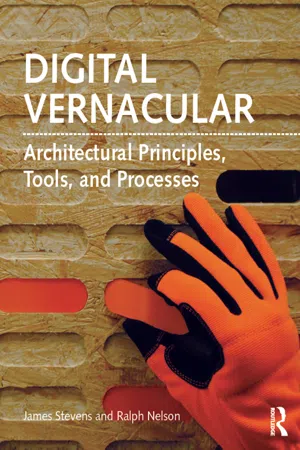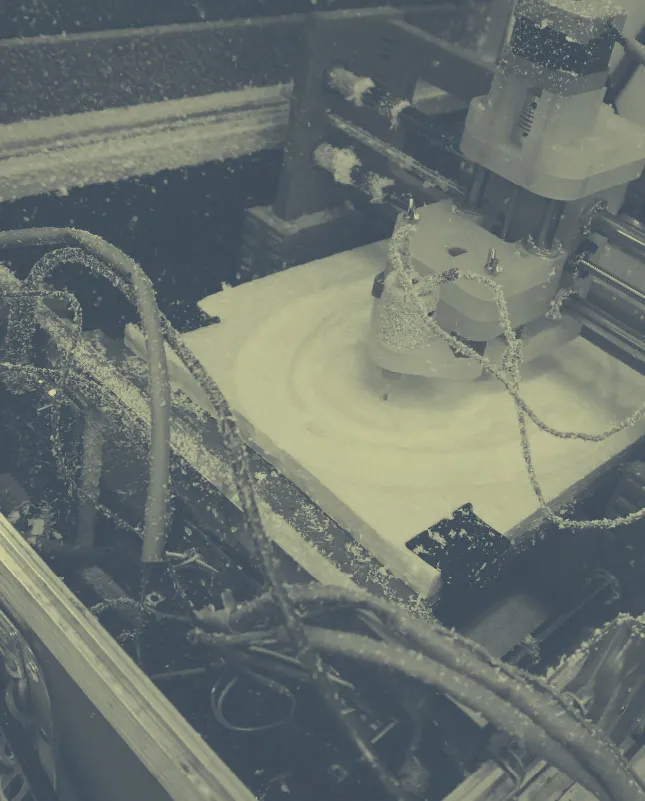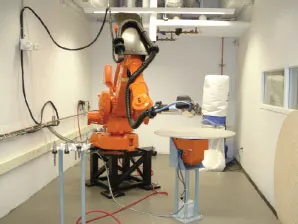![]()
TOOLS
![]()
Fig. 2.1
Once the promise of a new future, the jet-pack still tugs at the heartstrings of technoromantics
ON TOOLS
In his book Technoromanticisim, Richard Coyne describes a “Golden Age” when culture existed in a pre-literate state and the hand was the prehensile tool.24 Learning and understanding were not achieved by reading and writing, but by touching, feeling, and doing—the basis of all mechanization.25 Our contemporary digital world presents us with new digital tools that allow a designer to reconnect with the haptic nature of architecture. Given the possibilities provided by digital tools, however, makers can easily become sidetracked into imagining a digital utopia. Rooted in practical traditions, the Digital Vernacular seeks to avoid this digression through the careful selection of tools and the reconciliation of the tangible and digital. The intent is not to impede progress or creativity but rather to root the basis of work in the conditions of the present rather than romantic notions of the future (figure 2.1).
Present technological conditions have opened new technologies to architects that were once out of reach. The Massachusetts Institute of Technology (MIT) has developed a set of readily available digital tools to distribute to its many Fab Labs around the world. The technology serves as an example of the Digital Vernacular by combining open sourced and economically viable tools that serve a community of individuals with diverse backgrounds and skills.26
Access to tools, knowledge and material is highly dependent on time and place, as is the vernacular. Therefore, the digital tools available to one architect may not be available to another. The contextual shift creates a dilemma. Which digital tools are and are not vernacular? In the simplest terms, the digital tool that can be designed, built and maintained by the architect is vernacular. But which architect? The one in New Delhi or the one in Detroit? The one in 2014 or 2050? These variables are ever changing, as is the vernacular; thus it would be naive for one publication to offer a purportedly definitive list of Digital Vernacular tools. However, it is possible to learn from the principles provided in this publication to draw some conclusions about which tools tend to fall into the realm of the Digital Vernacular and those that do not. Open source CNC, Laser, and 3D printing technologies clearly fall into the category of the vernacular. All can be built by the architect (in New Delhi or Detroit) using readily available sourced parts and easily accessible instructions. When the tool fails—and it will—the designers can quickly make repairs with the help of a community of makers assembled on the Internet. Just as easily as we can include these technologies in the category of the vernacular, we can exclude others. Most 6-axis robotic arms cannot be obtained and maintained in a vernacular way (figure 2.2). Many still cost hundreds of thousands of dollars, and repairs must be made by a specialist. Large-scale additive technologies based on 3D printing also fall outside the vernacular, with most successful full-scale builds existing in the academy or in large corporations.
Fig. 2.2
6-axis Robot, Carnegie Mellon University
Architects working with the digital vernacular are just as likely to get digital tool knowledge from someone in the regional or international community as they are from a local colleague or service provider.
The Internet has created a conversation around what “place” and “community knowledge” are and where they exist. Architects working with the Digital Vernacular are just as likely to get digital tool knowledge from someone in the regional or international community as they are from a local colleague or service provider. If a 3D printer fails in Detroit and a maker in China provides troubleshooting knowledge the architect requires, what is the “place” of the community?
Rapid technological advances continue to introduce and deliver digital fabrication tools that are considered vernacular and accessible to an increasing number of people. For example, the Digital Vernacular tools of 2008 did not even include 3D printing. Four-plus axis CNC technology would have also been considered highly specialized at that time. Therefore it is easy to conclude that the fluid nature of variables that determine a Digital Vernacular tool will change with time. We anticipate that several digital tools currently excluded from this publication will evolve and enter the realm of the vernacular in the near future.
TOOL EVOLUTION AND IMPACT
The economic forces that have brought Digital Vernacular tools within reach of more architects and makers can be seen in the fluctuations of wage-to-tool cost ratios over the past 100 years in the United States. In 1922, a carpenter in the U.S. could expect to make $1.00 per/hour,27 while a circular saw sold by Hibbard Spencer Bartlett & Co. (1922) would cost $285, making the ratio .35 per cent.28 In contrast, a carpenter in 2010 earning $19.00 per/hour can expect to pay around $10,000 for a new three-axis CNC, which results in a ratio of 0.19 per cent.29 With a ratio as low as 0.19 per cent, it is easy to conclude that the wage-to-tool cost ratio puts today’s digital fabrication technology within reach of the vernacular trades, makers and architects. This conclusion is further supported by the observation that in 1996, an entry-level CNC cost approxima...



